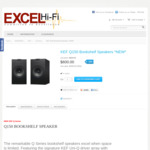Cheaper than the last deal which was $673.37 Delivered.
Currently $715 Delivered @ Addictedtoaudio.
Shipping costs may vary depending on location. I put in Sydney and shipping was free.
Shipping insurance is available at extra cost.
Note: Please read the shipping information provided on the website, looks like they may use courier depending on the product, in which case you will need to sign on arrival.
Q150 BOOKSHELF SPEAKER
The remarkable Q Series bookshelf speakers excel when space is limited. Featuring the signature KEF Uni-Q driver array with Computational Fluid Dynamics (CFD) port design, the Q150s deliver detailed natural sound with high clarity and tight bass.
"SIT ANYWHERE" UNI-Q SOUND
At the heart of the evolved Q Series is the Uni-Q driver array. The signature innovation places the tweeter in the acoustic centre of the midrange and bass cone, bringing the acoustic ideal of a single point source closer than ever to realisation. The result is a more detailed, accurate three-dimensional sound image, which is dispersed more evenly throughout the room than is possible with any conventional speaker. Uni-Q's ultra-wide dispersion is further enhanced through KEF's 'tangerine' waveguide over the tweeter dome.
NEW SYSTEM DESIGN
To optimise the high resolution purity of the Q Series bookshelf speakers, the Uni-Q driver is repositioned to the center of the cabinet to reduce unwanted internal resonance and adding refinement to sonic clarity and detail. With the addition of the damped tweeter loading tube providing a gentle termination of sound produced from the back of the tweeter, lower treble performance is improved dramatically and a new low-distortion inductor on the crossover provides cleaner bass.
CFD-DESIGNED PORT
Featuring a Computational Fluid Dynamics (CFD) port design with the port repositioned to the rear of the speaker, clarity is improved by reducing the audibility of the midrange leakage through the port.
Specifications:
Dimensions ( H x W x D): 300 x 180 x 272 mm (11.8 x 7.1 x 10.7 in.)
Weight: 5.9 kg (13.0lb)
Design: 2-way bass reflex
Drive Units: 130mm aluminum Uni-Q 25mm vented aluminum dome HF
Crossover Frequencies: 2.5kHz
Sensitivity (2.83V/1m): 86 dB
Maximum Output (SPL): 107 dB
Impedance: 8 Ohms
Amplifier Requirements: 10 - 100W
Frequency Response (±3dB): 49Hz - 40kHz


Also please take the recommended power requirements with a grain of salt.
Typically KEF’s require high-power amplifiers for optimal performance, even when listening at low-volume levels.